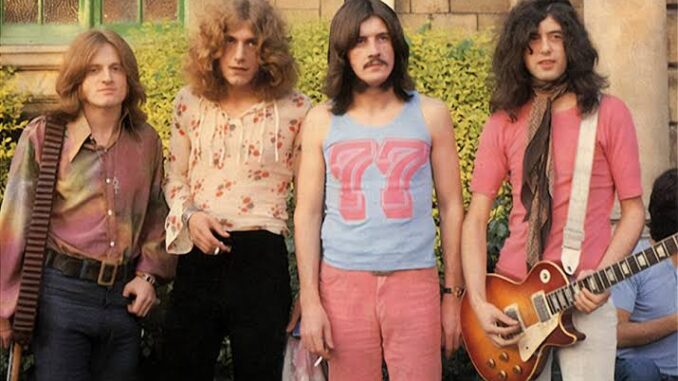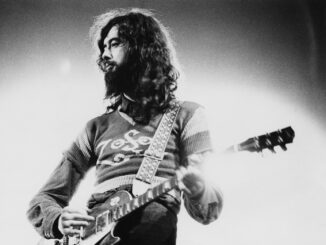
The Untold Story Behind Led Zeppelin’s Most Mysterious Song – Even Hardcore Fans Don’t Know This
Led Zeppelin’s music has stood the test of time, echoing through generations with raw energy, unmatched talent, and a mystique that no other band has quite managed to replicate. While hits like Stairway to Heaven, Whole Lotta Love, and Kashmir dominate classic rock playlists, there exists a song that’s flown just beneath the radar—a song surrounded by mystery, speculation, and even a touch of the supernatural.
We’re talking about “In the Light.” A deep cut from the 1975 Physical Graffiti album, this track has long puzzled even the most dedicated Zeppelin followers. But what makes it truly fascinating isn’t just its experimental sound or haunting vocals—it’s the story behind how it came to life, what it may really mean, and why Jimmy Page himself has remained eerily quiet about it in interviews.
A Song Shrouded in Shadows
“In the Light” opens with a strange synthesizer drone created by John Paul Jones using a bowed acoustic guitar run through an ARP synthesizer—an eerie, almost otherworldly sound that sets the tone for what follows. The lyrics appear uplifting on the surface, speaking of hope, guidance, and the end of darkness. But some fans have long suspected there’s more to the story.
When Physical Graffiti was being recorded at Headley Grange, the same remote mansion where “Stairway to Heaven” was born, the band reportedly experienced several unexplainable events—flickering lights, strange sounds, and feelings of unease. While such tales are easy to dismiss as rock ’n’ roll folklore, it’s worth noting that Page was deeply interested in the occult, particularly the teachings of Aleister Crowley.
This brings us to the center of the mystery.
Jimmy Page’s Silent Obsession
Jimmy Page was more than just a casual follower of the occult—he was obsessed. He bought Crowley’s former home, Boleskine House, on the shores of Loch Ness. He even named Led Zeppelin’s record label “Swan Song,” a term loaded with esoteric symbolism. Page’s fascination wasn’t just aesthetic; it seeped into the music.
And nowhere is that more apparent than on In the Light.
The lyrics—“And if you feel that you can’t go on / And your will’s sinkin’ low / Just believe and you can’t go wrong”—have a duality to them. While they appear to promote hope, some interpret them as veiled references to enlightenment, spiritual awakening, or even initiation into secret knowledge.
Page has never spoken in detail about the song’s meaning. In fact, in the few interviews where In the Light was mentioned, he often deflected or shifted the focus. Why the secrecy?
Some insiders believe In the Light was originally conceived during a series of jam sessions late at night—sessions Page referred to cryptically as “otherworldly” in his private journals. These writings, never publicly released, were reportedly seen by a former roadie who claimed the song was “a tribute to a being of light… not necessarily divine.”
Was Page experimenting with channeling music from a higher—or perhaps darker—source?
The Lost Tapes and the Abandoned Version
Another layer to this enigma comes from the existence of an earlier version of In the Light, known among diehard collectors as Everybody Makes It Through. This alternate take has different lyrics, a slightly different structure, and a less polished sound. It’s raw and strange—almost like a ritual in song form.
This version was never officially released until it appeared in the 2015 remastered edition of Physical Graffiti. Some fans believe it was buried intentionally. The alternate lyrics, when compared side by side with the final version, are notably darker and more cryptic—referring to shadows, barriers, and a “hidden hand.”
Why was this version scrapped? Why did it take four decades for it to see the light of day?
According to engineer Ron Nevison, who worked with Zeppelin in the mid-70s, Page was “very particular about what got out there.” He reportedly referred to the song as “too revealing” in its early form. Too revealing of what, exactly?
A Message Only the Few Will Understand?
There’s a theory circulating in corners of Zeppelin fandom that In the Light was written not for the public—but for a select group of initiates, or people “in the know.” Like a puzzle wrapped in poetry, it’s believed the song may contain coded messages, instructions, or metaphors known only to those with occult knowledge.
Some go even further, suggesting that In the Light wasn’t inspired by Page’s obsession with the occult—but was actually dictated through it. That’s right: channeled. Page, sitting alone with his guitar and his strange, mystical books, may have tapped into something beyond explanation.
Sound crazy? It might. But Led Zeppelin has never been a band to play it safe or stay within the lines of convention.
Final Thoughts – Is the Mystery Just Beginning?
Decades after In the Light was released, the song remains one of Led Zeppelin’s most haunting, least understood works. It’s a spiritual outlier in a catalog full of raw power and grandeur. And maybe that’s the point. Maybe Page and Plant wanted to leave a breadcrumb trail for the curious few.
As with all things Zeppelin, the truth lies somewhere between genius, madness, and myth. Whether you see In the Light as a beautiful song of hope or a cryptic message from the shadows, one thing is clear: it continues to shine in ways we may never fully understand.
And for a band that built its legacy on mystique, there could be no greater legacy than that.

Be the first to comment